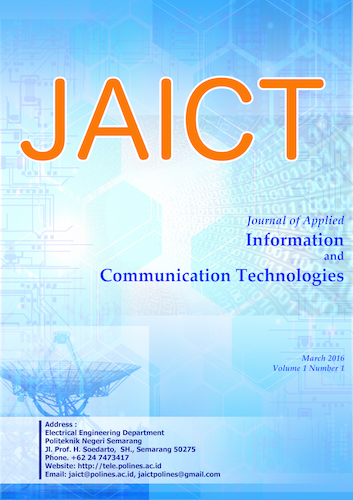Comparison of Energy Consumption of Wireless Sensor Network at Various Topology Deployment: Array, Grid, and Random
DOI:
https://doi.org/10.32497/jaict.v1i1.426Keywords:
Wireless Sensor Network, Energy Consumption, Topology, Array, Grid, RandomAbstract
This paper is review wireless sensor network and it”™s energy consumption at different deployment methods. Wireless Sensor Networks (WSN) are emerging with many applications, because of the advances in large scale wireless communications. These networks are deployed to serve single objective application, with high optimization requirements such as power saving. The WSN design problem is of high complexity, and requires robust methodologies, including simulation support. We use NS2 as simulation program for this model. In this paper, the authors compare the energy consumption on three different deployment methods of WSN. These deployment methods refer to topology deployment. In this simulation, we deploy WSN on grid, array, and random topology. We use different numbers of WSN nodes for showing the scalability. We use AODV as routing protocol and CBR as the traffic. After that, we compare the energy consumption that consume by that networks. Based on simulation result, the array topology is the best topology for deployment. This topology is the lowest on energy consumption, 0.560%.
References
Ian F. Akyildiz, Mehmet Can Vuran, “Wireless sensor networks” John Wiley & Sons Ltd, West Sussex, United Kingdom. 2010.
Adnan Iqbal, Bernard Pottier “Meta-Simulation of Large WSN on Multi- core Computer,” LabSTICC, UBO, Brest, France. 2010.
Antonis Antoniou, “Congetstion Control in Wireless Sensor Networks”, Maste”™s Thesis, University of Cyprus, 2007.
Ewa Niewiadomska-Szynkiewicz, Piotr KwaÅ›niewski, and Izabela Windyga, “Comparative Study of Wireless Sensor Networks Energy-Efficient Topologies and Power Save Protocols”, Journal of Telecommunications and Information Technology, vol 3., 2009.
Shilpa Dhar, “Energy Aware Topology Control Protocols for Wireless Sensor Networks”, Master”™s thesis, Louisiana State University and Agricultural and Mechanical College, USA, 2005.
Shilpa Dhar, “Energy Aware Topology Control Protocols for Wireless Sensor Networks”, Master”™s thesis, Louisiana State University and Agricultural and Mechanical College, USA, 2005.
Chalermek Intanagonwiwat, “Directed Diffusion: An Application- Specific And Data-Centric Communication Paradigm For Wireless Sensor Networks”, Doctor”™s Dissertation, The Graduate School University Of Southern California, Usa, 2002.
Ramaraju Kalidindi, “Energy-Rate Based Mac Protocol for Wireless Sensor Networks And Key Pre-Distribution Schemes”, Master”™s Thesis, Louisiana State University And Agricultural And Mechanical College, Usa, 2005.
Jing CHEN, Hong SHEN, and Hui TIAN, “Energy Balanced Data Gathering in WSNs with Grid Topologies”, in Seventh International Conference on Grid and Cooperative Computing, 2008.
W. Jeong And S. Y. Nof, “Optimal Deployment Of Collaborative Wireless Microsensors In Manufacturing Facilities”, 19th International Conference On Production Research, 2007.
S.Anandamurugan, Dr.C.Venkatesh, “Reducing Power Consumption in Wireless Sensor Networks by using Terrain Based Probabilistic Forwarding Scheme (TBPFS)”, GESJ: Computer Science and Telecommunications, vol. no.4(27), ISSN 1512-1232, 2010.
Dusan Stevanovic and Natalja Vlajic, “Performance of IEEE 802.15.4 in Wireless Sensor Networks with Mobile Sink Implementing Various Mobility Strategies”, IEEE Journal, 2008.
Wei Li and Chirstos G. Cassandras, “A Minimum-Power Wireless Sensor Network Self-Deployment Scheme”, IEEE Communication Society, WCNC, 2005.
Seong-Soon Joo, Sang Joon Park, Cheol Sig Pyo, and Jong-Suk Chae, “Configuration of Randomly Deployed WSN with Estimation of Node Density”, in ICACT Feb 17-20, 2008, ISBN 978-89-5519-136-3.
Homepage of ns-2. http://www.isi.edu
Downloads
Published
Issue
Section
License
Authors who publish with this journal agree to the following terms:Authors retain copyright and grant the journal right of first publication with the work simultaneously licensed under a Creative Commons Attribution License that allows others to share the work with an acknowledgement of the work's authorship and initial publication in this journal.
Authors are able to enter into separate, additional contractual arrangements for the non-exclusive distribution of the journal's published version of the work (e.g., post it to an institutional repository or publish it in a book), with an acknowledgement of its initial publication in this journal.
Authors are permitted and encouraged to post their work online (e.g., in institutional repositories or on their website) prior to and during the submission process, as it can lead to productive exchanges, as well as earlier and greater citation of published work (See The Effect of Open Access).






